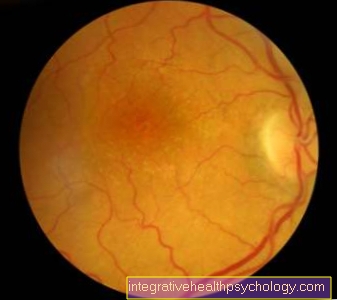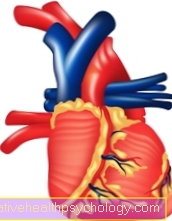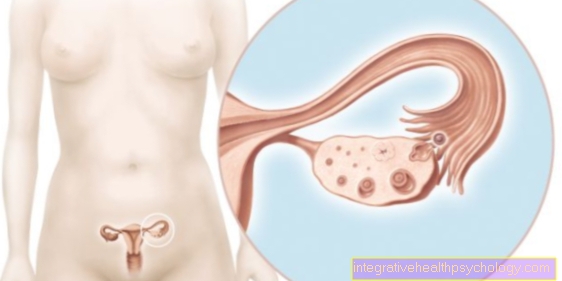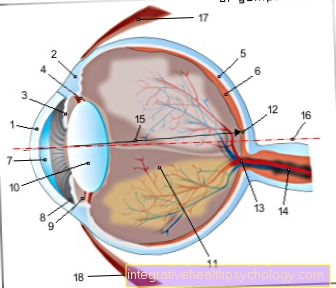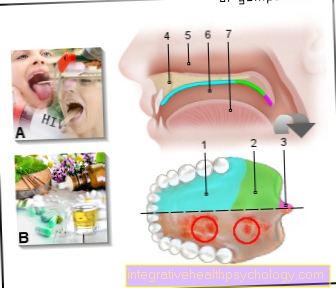Chagas disease
Synonyms in a broader sense
Chagas disease, American / South American trypanosomiasis
definition
In the Chagas disease it is an infectious disease caused by a certain Parasites with the name "Trypanosoma cruzi" caused.
Chagas disease was first discovered by the Brazilian in 1909 Doctor Carlos Chagas and is named after him.
distribution
Since the Pathogen Trypanosoma cruzi (Chagas disease) has its natural habitat in Central and South America, the disease is mainly common there.
However, there are also increasing cases of imported diseases in other countries such as Spain and the USA, where many immigrants from Latin America live. Overall, one assumes about 16-18 million infected people worldwide.
Pathogen
The pathogen Trypanosoma cruzi is a typical parasite, i.e. a living being that is dependent on another organism and causes damage to it.
Of the Chagas disease pathogen is counted among the parasites to the protozoa, more precisely to the flagellates, and is above all at Dogs, Cats, Rodents and armadillos to find. Trypanosoma is transmitted from these animals to humans via a nocturnal predatory bug.
This Predatory bugs mostly live in slum areas in close proximity to people and seek shelter in small cracks or thatched roofs during the day. At night, the bugs then seek out people with the help of thermoreceptors and immediately after their blood meal they deposit a drop of feces that can contain trypanosomes. The affected person feels one when the bug is bitten itching and rub the causative agent of Chagas disease directly into the wound, which starts the actual infection.
In addition to a transmission of trypanosomes by predatory bugs are also Blood transfusion infections Organ transplant or the Breast milk possible.
Symptoms
If a person is infected with trypanosomes, this does not necessarily mean that he is also sick (Chagas disease) becomes. In 60-70% of cases, the infections with trypanosomes run without any symptoms.
If symptoms do occur, these are usually lesions at the site of the bug, especially at first Redness and Swelling.
These lesions are also called "Chagom" designated. If such a chagom is localized on the eyelid, one also speaks of it "Romana character".
This is very characteristic of an infection with trypanosomes, as the eyelids can be easily attacked by the nocturnal bedbugs. After all, the head of a sleeping person is usually not covered by a blanket and the skin on the eye is particularly thin.
About two weeks after the transfer the bugs transfer the trypanosomes into the human blood system. This activates the body's own Immune defense and brings in general feeling of illness and malaise, fever, Lymph node swelling, possibly reddened skin and an enlargement of liver and spleen with himself. Inflammation of the heart muscle is feared as a complication of the disease at this stage.
Most patients recover from this acute phase within 1 to 2 months and then initially feel subjectively healthy again, lymph node swelling and enlargement of the liver and spleen are no longer present. This phase can be without symptoms 10-20 years persist and is also called latent phase designated. While the patient actually feels good, the trypanosomes in the human body, especially in muscle cells and connective tissue cells, survive and multiply.
In about 60% of the cases, this ultimately leads to "Chagas Syndrome"which the chronic phase the disease. The Chagas syndrome is due to diseases of the heart (Heart failure, low blood pressure, very slow pulse), Enlargement of the internal organs, difficulty swallowing due to a Inflammation of the esophagus, Flatulence, constipation and the involvement of central nervous system (brain and Spinal cord), the prognosis is often poor.
diagnosis
Based on the symptoms a patient shows, there is a suspicion of a Chagas diseaseso various tests can be performed.
in the acute stage of Chagas disease Sometimes it is possible to detect the pathogen directly microscopically in blood smears or samples of body tissue.
In the chronic phase of Chagas disease one tries above all to detect antibodies against trypanosomes. Antibodies are special proteins that are produced by the immune cells (immune system) of the body to fight pathogens.
Another way to detect the pathogen is the so-called "Xenodiagnosis". This is a procedure that is used mainly in the countries where the Chagas disease is applied.Here, predatory bugs that have not yet come into contact with trypanosomes are grown in the laboratory skin of the patient so that they can have a blood meal. After a few weeks, one then searches for trypanosomes in the digestive tract of these bedbugs; if these are found, then one knows that the patient in question is actually on the Chagas disease suffers.
therapy
Basically, the Chagas disease The earlier it is recognized, the better it is to be treated.
To drug therapy are the two substances recommended by the WHO Nifurtimox and Benznidazole to disposal. Unfortunately, both drugs have a wide range of side effects and their effectiveness is controversial. When using medication, among other things mental changes, sleepiness such as Disorders of the gastrointestinal tract how diarrhea and Vomitassociated with weight loss.
In Germany, Austria and Switzerland are Nifurtimox and Benznidazole not allowed.
prophylaxis
Since so far no vaccines exist against Chagas disease, the focus is primarily on combating the predatory bugs as the carriers of the pathogen.
Since the Predatory bugs during the day in small ones Cracks in wood, Wattle and straw stop, it would be very effective to erect brick or concrete structures with a solid roof, but of course this is not possible in many areas, so mainly insecticides are sprayed. Also offer good protection floor-length mosquito nets.


